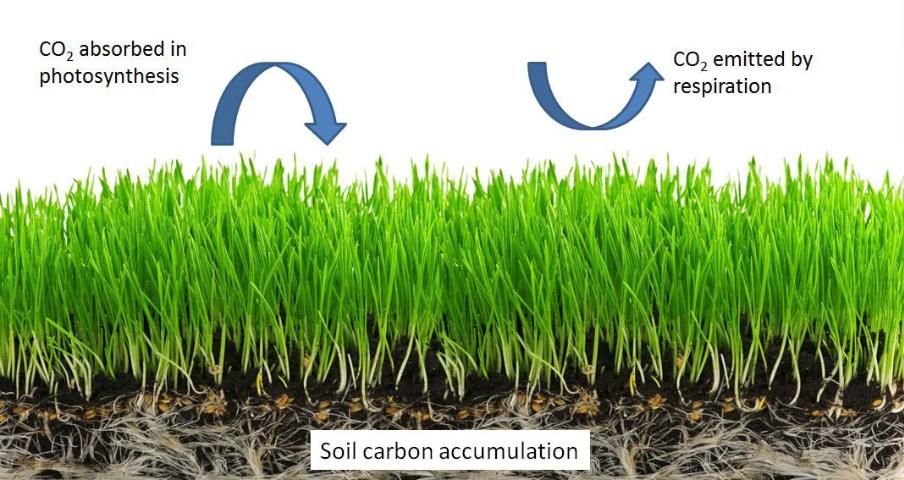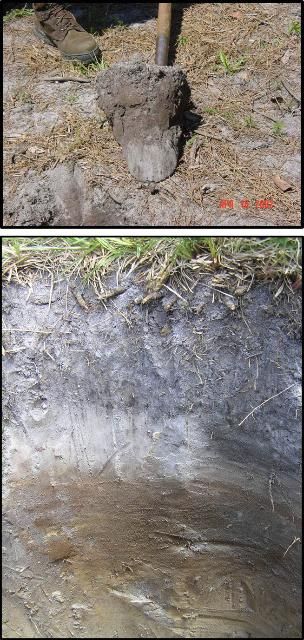This publication provides basic information about the important role of native and improved pastures (referred to as grazing land) in sequestering carbon from the atmosphere. Because of the relatively high sequestration rates and extensive area, grazing land represents an important component of terrestrial carbon dioxide (CO2) offset and is a significant sink for long-term carbon sequestration and greenhouse gas mitigation. This publication contains information for stakeholders, students, scientists, and environmental agencies interested in enhancing ecosystems services provided by grazing lands.
Global Carbon Cycle
The global carbon cycle consists of complex processes that control the movement of carbon between the atmosphere, land, and oceans. Although natural processes dominate the carbon cycle, human-induced activities can also alter these carbon transfers. In the atmosphere, carbon is mainly present as carbon dioxide (CO2). Large amounts of carbon are also present in the soil, primarily as soil organic matter. Soil organic matter plays a key role in determining soil quality and its potential to produce food, fiber, and fuel. During the past two decades, the global carbon cycle has received significant attention because of its role in global climate change.
Two important global topics are the rising atmospheric CO2 concentrations caused by human-induced activities (primarily combustion of fossil fuels) and the potential effects on climate change. In addition to CO2, increased atmospheric concentrations of nitrous oxides (N2O and NO) and methane (CH4) are also believed to cause global warming. Carbon dioxide, nitrous oxides, and methane (also known as greenhouse gases) can trap heat in the atmosphere and contribute to global warming. Levels of several important greenhouse gases have increased by 25% since large-scale industrialization began approximately 150 years ago, and this increase is primarily caused by energy use.
Plants remove carbon from the atmosphere during photosynthesis, a process done without human intervention. However, to address the contributions made by humans, the carbon must be stored or sequestered. Typically, carbon in plants undergoes several conversions. Some conversions are rapid, such as the addition of fresh plant material to the soil, while others may take long periods of time. For example, a large amount of carbon is already sequestered in our soil.
What is soil carbon sequestration and why is it important?
Carbon sequestration refers to the process of transferring CO2 from the atmosphere into the soil (Figure 1). Once carbon is transferred to the soil, carbon can be stored for decades or longer. This sequestering process may be accomplished by 1) increasing crop yields through the use of management practices such as fertilization, irrigation, and grazing management, and 2) reducing decomposition of existing or new soil organic matter.
Soil carbon sequestration helps offset emissions from combustion of fossil fuels and other human-induced activities. During the past decade, US agricultural soils overall have acted as a net sink of atmospheric CO2, sequestering approximately 12 million metric tons of carbon per year. Although agricultural soils can also emit CO2 to the atmosphere, adoption of best management practices (BMPs) for soil and cropping allowed agricultural soils to remove more carbon from the atmosphere than the soils release. Increasing carbon storage in soils offers significant accompanying benefits such as improved soil and water quality, reduced soil erosion, increased water conservation, and greater crop productivity.
Native and improved pastures are two types of land use that retain carbon in the soil. These land uses usually cause little soil disturbance, which reduces the carbon loss from organic matter and allows fresh plant materials from the grasses to become part of the soil organic matter over time. Figure 2 demonstrates a typical soil pit profile collected from a bahiagrass pasture in South Florida.

Credit: http://www.thinkstock.com

Credit: M.L. Silveira
Soil Carbon Sequestration in Grazing Lands
Grazing lands can be important sinks of atmospheric CO2 and play a major role in the overall carbon cycle fluxes. This land use contains approximately 10%–30% of the world's soil carbon reserves (Eswaran et al. 1993). Unlike tropical forests, where the majority of the carbon is stored in the vegetation, as much as 90% of the carbon pools in grazing-land ecosystems are located in the soil (Schuman et al. 2001), hence it can be readily transferred into more permanent storage in the soil. Because carbon stored below ground is more permanent than plant biomass, soil carbon sequestration in grazing lands provides a long-term alternative to mitigate atmospheric greenhouse gas emissions.
Several factors promote greater soil carbon accumulation in pastures as compared to agricultural lands, including high density of roots, root exudation, and, as stated previously, a lack of physical soil disturbance because of the absence of tillage. Researchers have estimated that from 29.5 to 110 million metric tons of carbon can be sequestered annually in grazing lands in the United States (Follett et al. 2001). Because native and improved pasturelands encompass an extensive area in the United States (~1/3 of the land area), small changes in the amount of carbon sequestered in grazing-land soils have significant consequences in the global carbon cycle. Reports have shown that an increase (or loss) of only 1% of the soil carbon in the top 4 inches of grazing-land soils is equivalent to the total carbon emissions from all US cropland agriculture (Follett et al. 2001). This trend underscores the importance of grazing lands to mitigate at least part of global atmospheric CO2 emissions.
Carbon sequestration rates vary by climate, topography, soil type, management history, and current practices. The majority of the grazing lands in the United States are located in arid and semiarid ecosystems; however, grazing lands in eastern regions receive more precipitation and, consequently, have greater potential to respond to management inputs. For example, because of the warm climate and ability to grow crops year-round in Florida, there is the potential to return great amounts of carbon to the soil as above-ground (i.e., dead leaves) and below-ground (i.e., roots, root exudates) plant inputs. However, carbon accumulation in Florida's soils remains a major challenge because of the fast decomposition rates in warm and moist conditions. Appropriate management practices that favor carbon inputs and minimize decomposition are the key to increase carbon sequestration in Florida soils.
Management Practices That Enhance Soil Carbon Sequestration
Current pasture management strategies (e.g., fertilization strategy and grazing management) are generally aimed at increasing forage production to match animal stocking rates or forage demand from hay. However, pasture management can also promote carbon storage in the soil. In fact, most techniques used to improve forage production promote carbon inputs to the soil and increase soil carbon sequestration. For instance, fertilization, irrigation, grazing management, fire regimen, introduction of legumes, and use of improved grass species can boost plant productivity while promoting soil carbon sequestration. Opportunities for increasing soil carbon sequestration in response to management practices vary in intensity and are specific to each ecosystem.
Studies have shown that when low-fertility soils receive fertilizer or lime, forage productivity and soil carbon levels generally increase (Conant et al. 2001). Research also shows that grazing intensity can have major impacts on soil carbon accumulation. Although overgrazing is often associated with reductions in soil carbon concentrations, proper grazing management can result in greater soil carbon concentrations than non-grazed systems. Well-managed grazing lands generally maintain or even increase soil carbon accumulation compared with native ecosystems. Also, livestock benefit from well-managed lands because the grass usually has higher nutrient concentrations because of proper fertilization (Silveira et al. 2009).
Future Outlook
Native and improved grazing lands are a significant sink for long-term carbon sequestration and play an important role in mitigating global climate change. Because grazing lands occupy a vast area throughout the world, small changes in the amounts of carbon stored in this ecosystem can have significant consequences in the overall carbon cycle and atmospheric CO2 levels. Although opportunities for increasing soil carbon sequestration in response to management practices are site-specific, grazing lands in Florida offer a unique opportunity to sequester large amounts of carbon.
However, global estimates show that a significant portion of grazing land area in the United States is being replaced by more intensive agriculture and urban development. This land-use trend is particularly true in Florida, where urban development is increasingly competing with natural resources for land. Reducing grazing land area and increasing management associated with land use intensification (i.e., converting extensively-managed pastures into intensively-managed agriculture or urban development) will change the amounts of carbon sequestered in grazing land soils. Continuation of this trend is expected to have major impacts on our regional climate, potential future carbon sequestration, and greenhouse gas emissions.
Carbon trading-related markets and the growing interest in carbon sequestration as mechanisms for environmental protection can change this scenario in favor of preserving grazing lands in Florida while reducing the rate of urbanization. While carbon markets potentially offer new income for farmers, the present outlook for this revenue is not bright. The recent recession and problems with assigning value for carbon sequestration have prevented a stable or significant carbon-trading market from developing in the United States. The European market, while still functioning, reflects a wait-and-see approach in both low carbon-credit trading volume and low prices. This agriculturally-based ecosystem service is unlikely to be adopted if there is no incentive to sequester carbon in grazing lands.
References
Conant, R.T., K. Paustian, and E.T. Elliott. 2001. "Grassland Management and Conversion into Grassland Effects on Soil Carbon." Ecol. Appl. 11: 343–55.
Eswaran, H., E. Van Den Berg, and P.F. Reich. 1993. "Organic Carbon in Soils of the World." Soil Sci. Soc. Am. J. 57: 192–4.
Follett, R.F., J.M. Kimble, and R. Lal. 2001. The Potential of U.S. Grazing Lands to Sequester Carbon and Mitigate the Greenhouse Effect. Boca Raton, FL: Lewis Publishers.
Schuman, G.E., D.R. LeCain, J.D. Reeder, and J.A. Morgan. 2001. "Carbon Dynamics and Sequestration of a Mixed-Grass Prairie as Influenced by Grazing." In Soil Carbon Sequestration and the Greenhouse Effect, special publication no. 57, edited by R. Lal, 67–75. Madison, WI: Soil Science Society of America.
Silveira, M.L., J.M. Vendramini, J.E. Rechcigl, and M.B. Adjei. 2009. Soil pH and Liming Issues Affecting Bahiagrass Pasture. SL292. Gainesville, FL: University of Florida Institute of Food and Agricultural Sciences. https://edis.ifas.ufl.edu/ss505